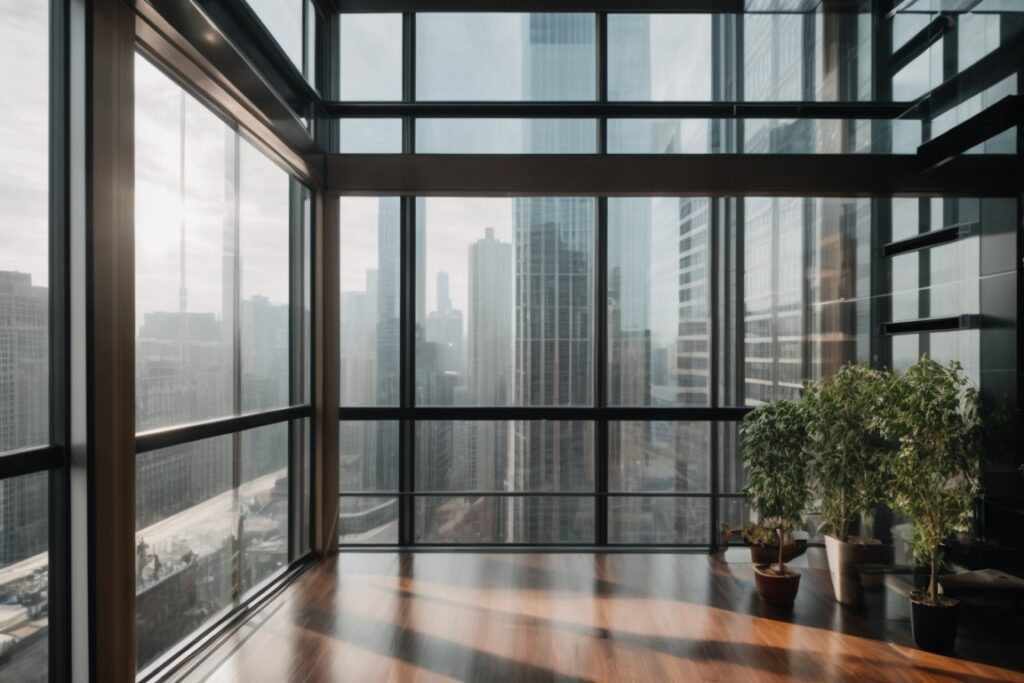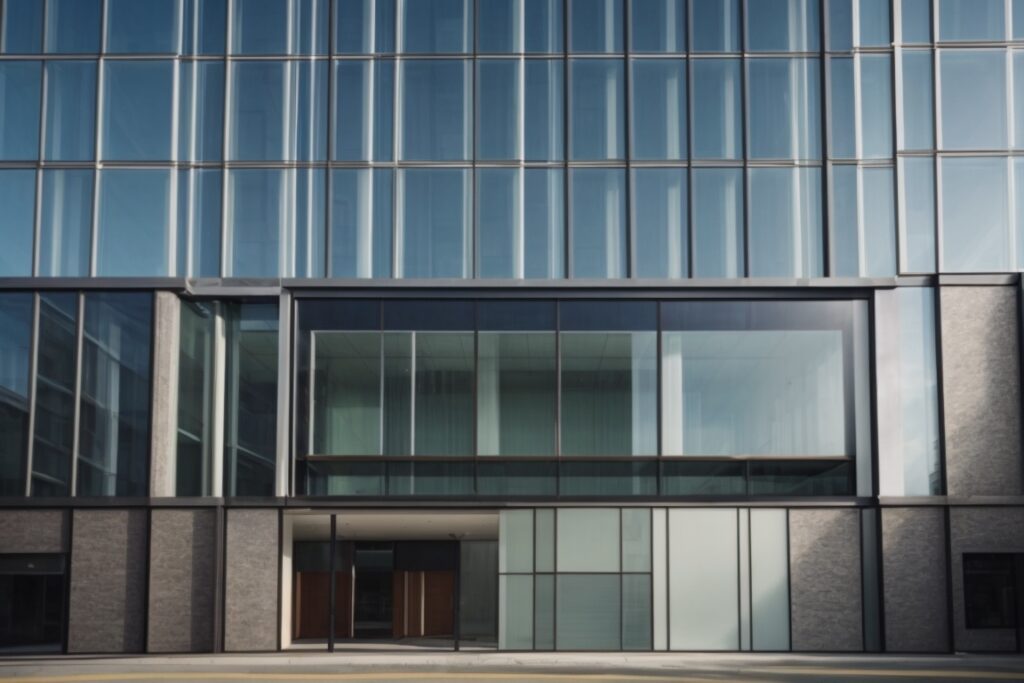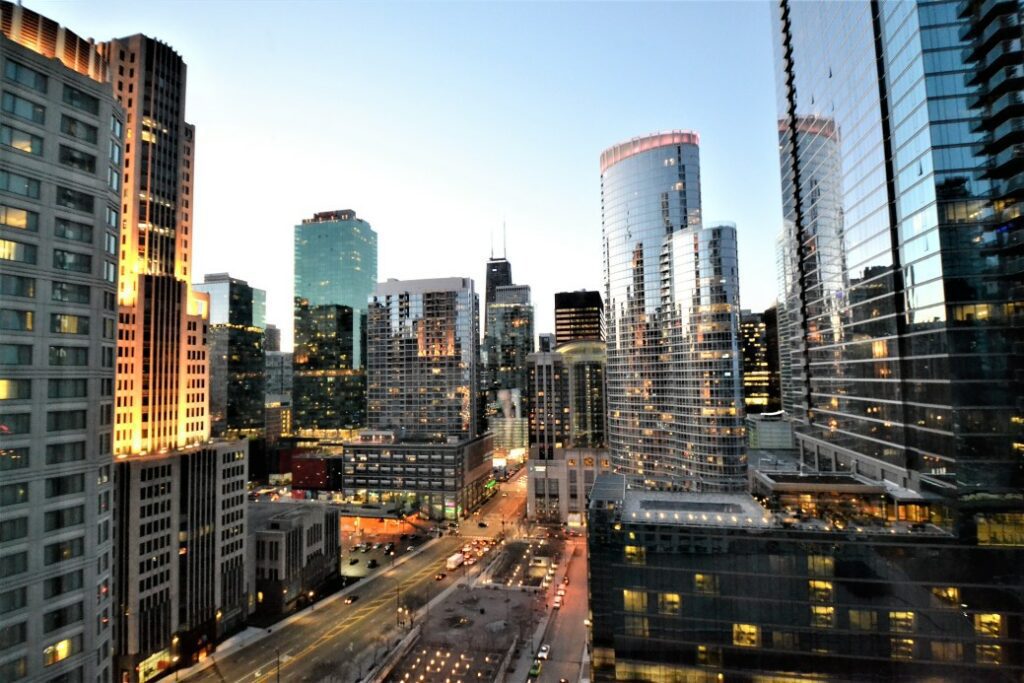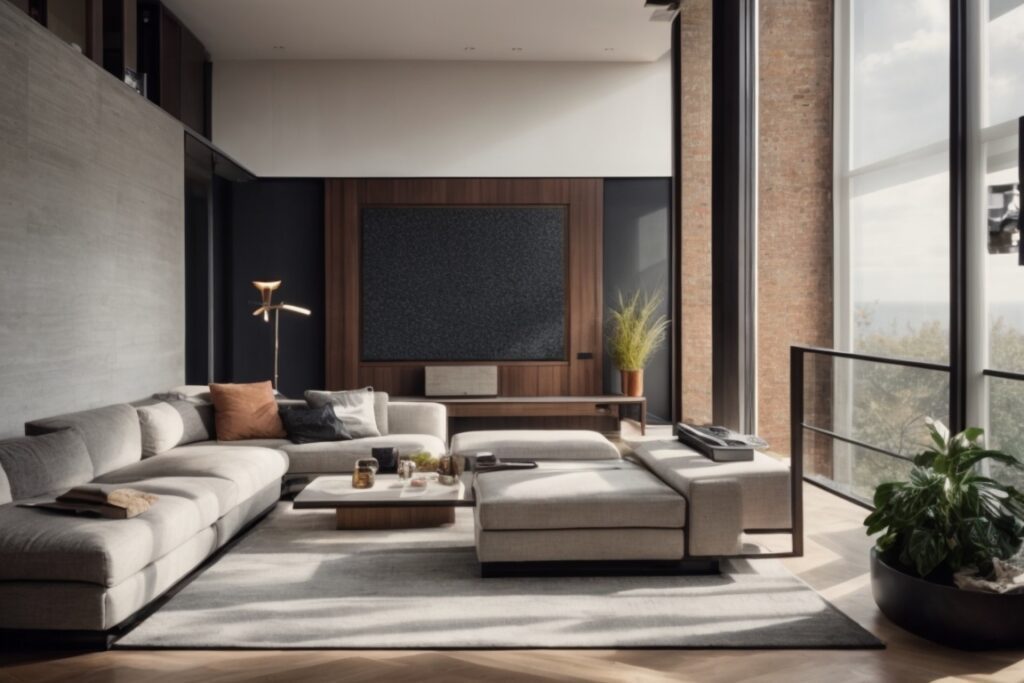
The Overlooked Challenge of Urban Heat in Chicago’s Architecture
In the bustling city of Chicago, architects and building owners face a growing challenge that often goes unnoticed amidst the towering skyline: the intense accumulation of heat within glass-paneled buildings. Despite their stunning visual appeal and the panoramic views they offer, these architectural marvels encounter a significant issue due to their vast glass surfaces. The problem stems from excessive sunlight exposure, which considerably elevates indoor temperatures, leading to discomfort for occupants and escalated energy costs.
This urban heat dilemma is particularly acute during the summer months when the sun is at its peak. Buildings that are predominantly made of glass absorb and trap heat, creating a ‘greenhouse effect’ that can make interior spaces unbearably warm. Not only does this affect the comfort levels inside these buildings, but it also puts a strain on air conditioning systems, increasing energy consumption and operational costs significantly.
Moreover, the impact of this excessive heat is not confined to the interiors alone; it contributes to the broader urban heat island effect, where city regions become significantly warmer than their rural counterparts. This phenomenon exacerbates air quality issues and general environmental sustainability in Chicago, making it a pressing concern for city planners and residents alike.
Thus, while the sleek, glass-fronted facades of Chicago’s buildings might define its modern cityscape, they also introduce an environmental challenge that needs urgent attention. The issue at hand is designing spaces that are not only aesthetically pleasing but also environmentally responsible and comfortable to occupy throughout the year.
Understanding the Roots of Inefficient Energy Management in Chicago’s Buildings
In Chicago, architectural aesthetics often prioritize stunning glass facades that define the city’s skyline. However, these expansive glass structures pose significant challenges regarding energy management, particularly in terms of heat gain and loss. The problem starts with the basic properties of traditional glass used in these buildings, which is inherently poor at insulating and controlling heat transfer.
During the summer, the sun’s rays penetrate these large glass windows, drastically increasing indoor temperatures and forcing HVAC systems to work overtime. This continuous cycle not only leads to increased energy consumption but also escalates long-term maintenance costs for building owners. Conversely, during Chicago’s harsh winters, the same glass windows lose a significant amount of interior heat, again pushing heating systems to their limits to maintain a comfortable indoor environment. The inefficiency of traditional glass in this climatic tug-of-war is a fundamental issue that affects many buildings across the city.
Severe Discomfort: Unchecked Heat Impact in Chicago Buildings
Without heat control window film, buildings throughout Chicago suffer from increased indoor temperatures, especially during sun-intensive days. This sustained heat buildup not only compromises the comfort of inhabitants but also strains air conditioning systems, leading to higher energy consumption and elevated utility bills. Such conditions can detrimentally impact productivity in workplaces and wellbeing in homes, pushing occupants towards costly solutions or, in worst cases, to vacate the premises during peak heat periods. The fiscal and physical discomfort experienced underscores the need for protective measures like heat control window films.
The Hidden Hazards of Untreated Windows in Chicago
In the bustling heart of Chicago, where the skyline is as much a part of home as the living room, many remain unaware of an insidious issue lurking right within their walls—inefficient windows. It’s an easy detail to overlook in the daily grind, but it poses serious repercussions for comfort, safety, and finances.
Imagine this: during Chicago’s harsh winters and sweltering summers, untreated windows allow heat to escape or enter, forcing HVAC systems to work overtime. This not only leads to discomfort during extreme weather but also results in soaring energy bills that can drain your finances without mercy. The repeated strain on your heating and cooling system accelerates wear and tear, leading to costly repairs or even premature replacement.
But the financial bleed is just one part of the narrative. Consider the impact on your health and that of your family: rooms that are too hot or too cold contribute to poor sleep patterns, reduced productivity, and even adverse health effects from mold growth due to condensation issues. Every corner of your living space can turn into an invisible battleground, where the very air you breathe might be compromising your well-being.
Ignoring this creeping threat today might mean facing a health and financial crisis tomorrow. While these windows silently detract from your quality of life, the solution is neither complicated nor unattainable. But recognizing the problem is just the first step—taking timely action to address it is crucial. How long before the hidden costs become too glaring to overthrow?
The Urgency of Installing Heat Control Window Film in Chicago Buildings
Chicago’s architectural aesthetics are heavily influenced by its large glass structures which, while visually stunning, pose a significant challenge in terms of energy efficiency and interior climate control. Given the city’s range of temperature extremes from blistering summers to freezing winters, the urgency in adopting heat control window films is more than just a comfort issue—it’s a pressing economic and environmental concern.
Procrastination in this matter leads to escalated energy consumption as HVAC systems labor harder to compensate for heat gain in summer and heat loss in winter. This not only drives utility bills up significantly but also increases the carbon footprint of these buildings. Timely application of heat control window film can mitigate these issues, transforming window systems from thermal liabilities into assets almost immediately. Without timely action, the compounded costs and environmental impacts are not just probable but guaranteed, making swift installation an essential move for any building owner in Chicago.
Transform Your Space with Heat Control Window Film in Chicago
Imagine the comfort and serenity of enjoying your Chicago home or office without the constant battle against heat and glare. Installing heat control window film is not just a practical decision; it’s an investment in your well-being and productivity. In a city that experiences diverse weather conditions, the ability to control indoor temperatures without relying heavily on air conditioning is not only cost-efficient but also environmentally friendly. Embrace a smarter, more comfortable living and working environment with this innovative solution.
Heat Control Window Film: The Smart Upgrade for Chicago’s Edifices
When considering enhancements for Chicago’s architectural marvels, one solution stands out not just for its functionality but for its integral role in elevating building performance—heat control window film. This product isn’t just an option; it’s the definitive upgrade for contemporary urban structures.
Heat control window film excels in refining the aesthetics of any building while simultaneously tackling the persistent issue of heat gain through windows. It is designed specifically to meet the challenges posed by Chicago’s varying climate. By installing this film, buildings gain a shield against excessive solar heat, making it not just a wise choice, but a necessary one for energy efficiency and comfort.
This window film is more than a simple add-on; it’s a crucial component in sustainable building management. It drastically reduces the need for air conditioning, cuts down on glare and limits UV exposure, which not only protects occupants but also extends the life of furniture and floors inside the building.
For building owners and managers, choosing heat control window film is an actionable step towards upgrading their properties. It’s an investment in longevity, efficiency, and aesthetic value. Engaging with this technology is not merely about enhancing window function—it’s about setting a new standard for building performance in Chicago’s dynamic skyline.
Opt for more than just improvement; choose transformation. Heat control window film is not just advantageous; it’s essential for modern architectural needs in Chicago. Enhance your building’s efficiency and aesthetic appeal comprehensively with this superior window solution.
Enhancing Chicago’s Skyline: The Advantages of Heat Control Window Film
When considering the challenges of maintaining comfortable interior temperatures in Chicago’s towering skyscrapers and residential buildings, heat control window film emerges as a standout solution. Primarily, this innovative film technology tackles the intense solar heat gain that can lead to uncomfortable indoor environments and skyrocketing energy costs. By applying a professionally installed heat control window film, buildings can significantly reduce the amount of heat that penetrates through windows without sacrificing natural light.
This film not only maintains colder indoor temperatures during hot summer months but also contributes to substantial energy savings by reducing the need for constant air conditioning. Furthermore, the added benefit of UV protection helps in preserving the color and integrity of interior furnishings. Its application is straightforward, causing minimal disruption to daily activities, making it an optimal solution for both new constructions and existing structures looking to enhance energy efficiency and comfort.
Additional Perks of Using Heat Control Window Film
Apart from its primary role in regulating temperature, heat control window film offers unforeseen benefits that enhance living spaces in Chicago. Not only does it reduce glare and UV exposure, thereby protecting interiors and health, it also subtly boosts privacy without compromising natural light. Moreover, this window treatment can contribute to a harmonious indoor ambiance, making it ideal for both homes and offices seeking a blend of functionality and style. Ultimately, this innovation elevates comfort and aesthetic appeal, proving itself as more than just a temperature control solution.
The Intelligent Choice: Embracing Heat Control Window Film in Chicago
In Chicago, where the urban landscape constantly battles with heat and light management, the importance of optimizing the efficiency and comfort of our living and working spaces cannot be overstated. The towering skyscrapers are not just a testament to architectural prowess but also present unique challenges in temperature regulation and sun protection.
Heat control window film emerges as not merely a reactive measure against these environmental challenges but as an intelligent strategy for forward-thinking property owners. By considering the installation of heat control window films, residents and businesses in Chicago are taking a crucial step toward managing solar heat gain and glare. This choice reflects a keen understanding of both the short-term comfort and the long-term energy savings that these films offer.
This proactive approach is about more than just enhancing the aesthetic appeal of the city’s skyline. It’s about predicting future climatic conditions and preemptively addressing the increasing energy costs. Installing heat control window film is akin to equipping buildings with a tool designed to enhance livability while adhering to sustainable building practices.
In essence, when you observe the shimmering glass surfaces of Chicago’s architectural marvels, what you’re seeing is not just modern design but a silent declaration of smart living and energy efficiency. This development in building technology weaves itself into the very fabric of the city’s ethos of innovation and practical adaptation. The move towards integrating heat control window film is an intelligent acknowledgment of Chicago’s commitment to maintaining its habitability, functionality, and beauty against the potential harshness of urban environmental forms.
Transform Your Space with Heat Control Window Film
Don’t let the harsh Chicago sun dictate your comfort and interior aesthetics. Opt for heat control window film today and enjoy enhanced privacy, reduced glare, and significant energy savings. Ready to upgrade your building’s efficiency and style? Contact us now to find out more about our solutions and take the first step towards a cooler, more comfortable environment in your Chicago property.







About The Author: Mike Kinsey
Mike Kinsey has more than a decade of experience installing window film in the Chicago area. His years of experience have allowed him to develop a deep familiarity with all of the different types and styles of window film on the market including the various security, privacy, decorative, and energy efficient options. Together, he and his team have completed hundreds of commercial and residential installs, totaling an accumulation of over 250,000 square feet. In addition to being an expert on top brands such as LLumar, C-Bond, HDClear, Solar Gard, Solyx, and Huper Optik, Mike is also certified by 3M, EnerLogic, and AIA for continuing education.
More posts by Mike Kinsey